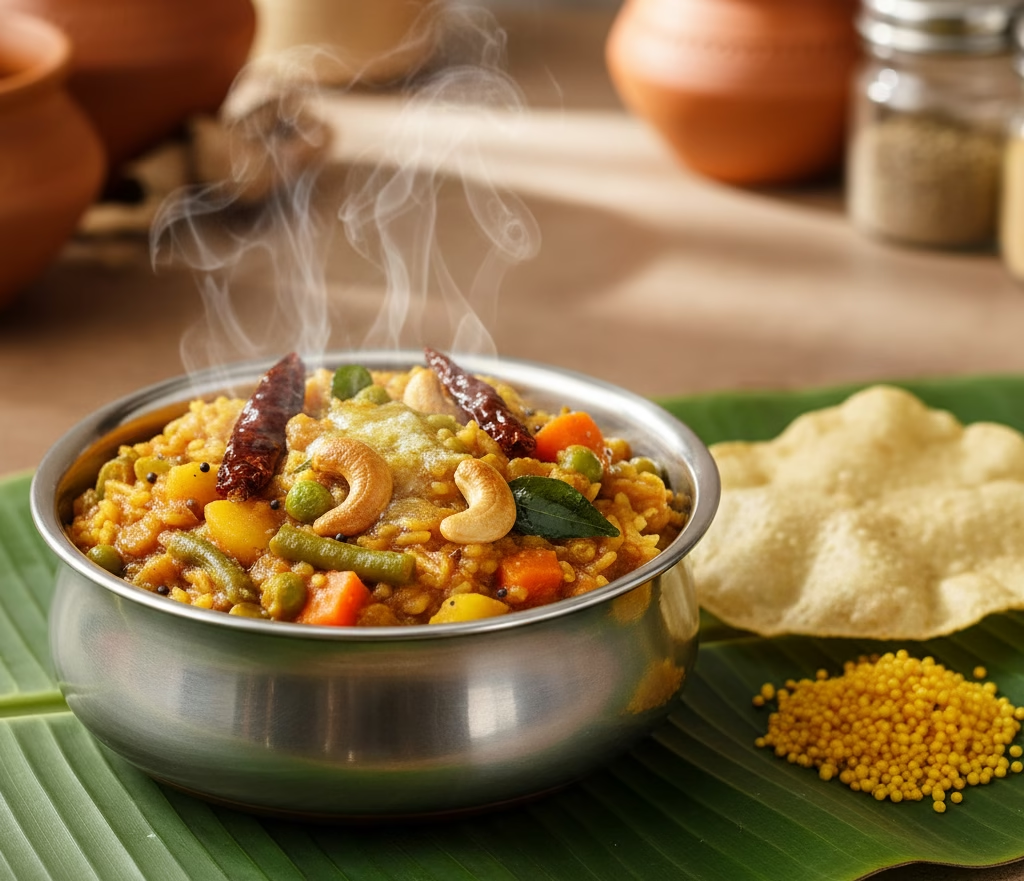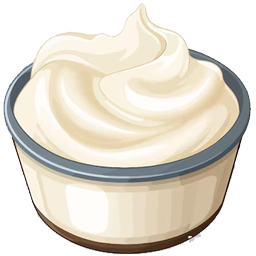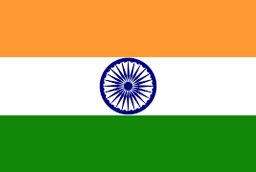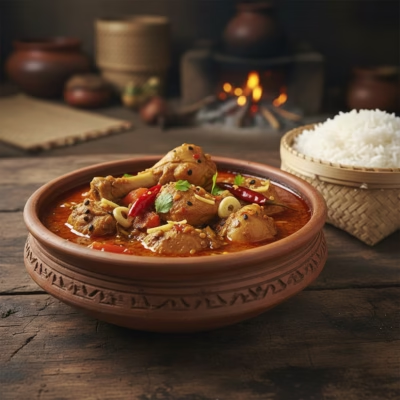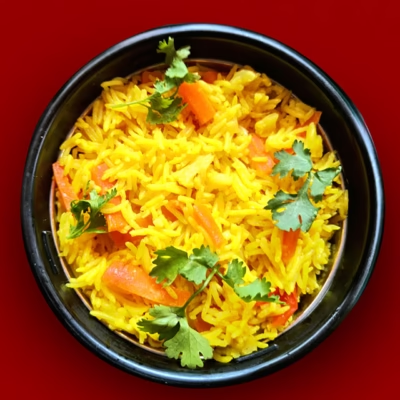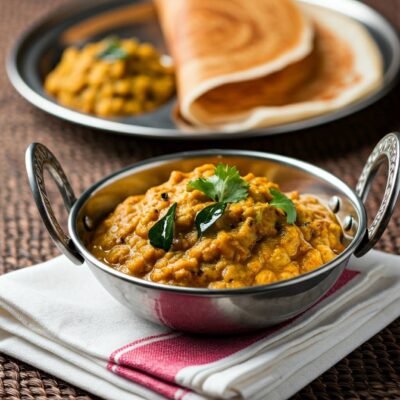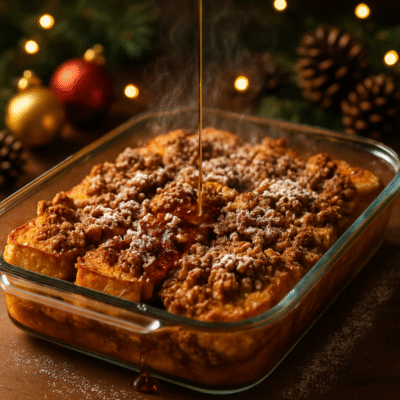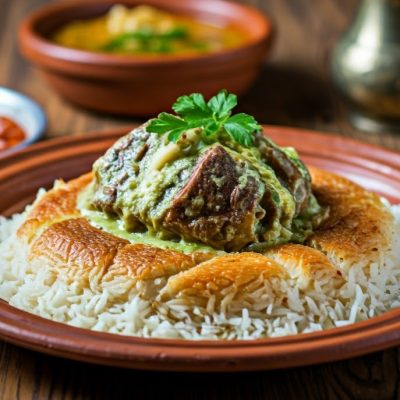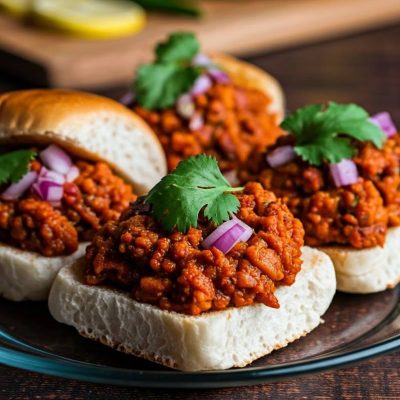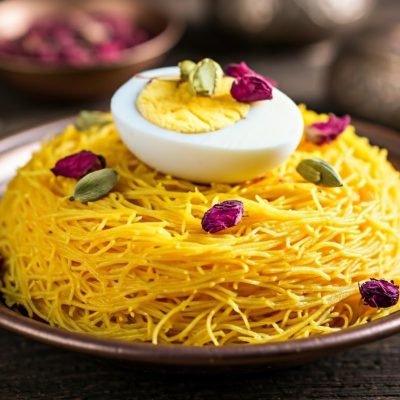Ingredients
For Pressure Cooking
- 1 cup Rice
- ½ cup Toor dal (pigeon peas)
- ¼ tsp Turmeric powder
- 4 cups Water
For Tamarind Mixture
- Tamarind – small lemon-sized ball (soaked in warm water, extract the juice)
- 1 tsp Jaggery (optional)
- Salt – to taste
For Vegetables (optional but recommended)
- 1 small, chopped Carrot
- 8, chopped Beans
- Drumstick pieces – few (optional)
- ¼ cup Green peas
- ½, chopped Capsicum
For Bisi Bele Bath Powder (or use 2 tbsp ready-made MTR powder)
- 2 tbsp Coriander seeds
- 1 tbsp Chana dal
- 1 tsp Urad dal
- 8 Dry red chilies
- 1 inch Cinnamon stick
- 4 Cloves
- ¼ tsp Fenugreek seeds (methi)
- 2 tbsp Grated coconut
- ½ tsp (for roasting spices) Oil or ghee
For Tempering
- ½ tsp Mustard seeds
- Curry leaves – few
- 8 Cashews
- 2 tbsp Ghee or oil
Directions
Bisi Bele Bath is a classic and comforting South Indian dish originating from Karnataka. The name literally means “hot lentil rice,” and it perfectly combines cooked rice, toor dal (pigeon peas), tamarind, and a variety of vegetables with a blend of aromatic spices. This hearty one-pot meal is both flavorful and wholesome, offering a balance of protein, fiber, and complex carbohydrates.
The dish is typically tempered with ghee, mustard seeds, curry leaves, and cashews, which adds a rich aroma and subtle crunch. Tamarind gives it a tangy flavor, while jaggery balances the spices with a hint of sweetness. Traditionally served hot, Bisi Bele Bath is enjoyed with crispy papad, boondi, or even a dollop of ghee on top.
Loved for its comforting texture and bold flavors, this versatile dish is perfect for lunch or dinner and reflects the authentic taste of Karnataka’s culinary heritage. It is vegetarian, nutritious, and can be easily adapted for a healthy meal without compromising on flavor.
Here’s the approximate nutrition breakdown for one medium bowl (about 350 g) of Bisi Bele Bath 🍲
| Nutrient | Amount | % Daily Value (approx.) |
|---|---|---|
| Calories | 320–360 kcal | — |
| Carbohydrates | 55 g | 18% |
| Protein | 10 g | 20% |
| Fat | 8 g | 12% |
| Saturated Fat | 2 g | 10% |
| Fiber | 6 g | 24% |
| Cholesterol | 0 mg | 0% |
| Sodium | 450 mg | 20% |
| Sugar | 5 g | — |
| Calcium | 80 mg | 8% |
| Iron | 2.5 mg | 15% |
| Potassium | 300 mg | 10% |
🌿 Health Benefits
✅ High in fiber – supports digestion.
✅ Rich in plant protein from toor dal.
✅ Contains complex carbs – gives steady energy.
✅ Antioxidant spices (like turmeric, cinnamon, cloves) support immunity.
✅ Low cholesterol & moderate fat when made with ghee in small amounts.
Nutrient Disclaimer: The nutrition information provided is an estimate for informational purposes only and may vary based on ingredients, portion sizes, and preparation methods. Always consult a nutritionist or dietitian for personalized advice.
Steps
1 Done | Cook Rice and DalWash rice and toor dal together. Add 4 cups water, turmeric, and pressure cook for 4–5 whistles until soft and mushy. Mash slightly and keep aside. |
2 Done | Prepare VegetablesIn a pan, add a little oil and sauté the chopped vegetables. Add a bit of salt and water, cover, and cook until soft. |
3 Done | Make Bisi Bele Bath Powder (if homemade)Dry roast all the spices listed under the “Powder” section one by one until aromatic. Add coconut last and roast lightly. Cool and grind into a fine powder. |
4 Done | Mix It AllIn a large pan, combine cooked vegetables, tamarind extract, jaggery, salt, and 2 cups water. Boil for 5–7 minutes. Add 2 tbsp Bisi Bele Bath powder and mix well. Add the cooked rice-dal mixture, stir continuously, and cook for 5–10 minutes. Adjust water consistency (it should be slightly thick but pourable). |
5 Done | TemperingHeat ghee in a small pan. Add mustard seeds, curry leaves, and cashews. When cashews turn golden, pour this tempering over the Bisi Bele Bath. Mix well. |
6 Done | 🍽️ Serving SuggestionServe hot with boondi, papad, or potato chips. Drizzle a spoon of ghee on top for extra flavor. |

